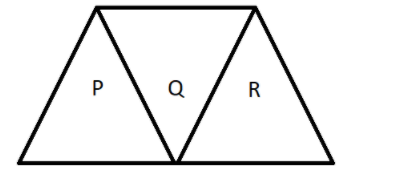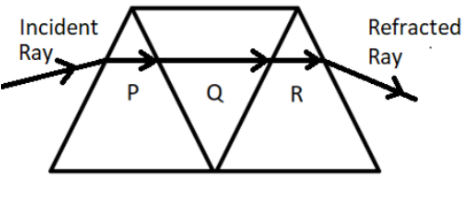
A given ray of light suffers minimum deviation in an equilateral prism P. Additional prisms Q and R of identical shape and material are now added to P, as shown in the figure. The ray will suffer:

A) Same deviation
B) Greater deviation
C) Total internal reflection
D) No deviation
Answer
217.5k+ views
Hint: The refraction of a ray of light happens because of the change in the refractive index of the medium through which the light passes. If there are no such changes, the light ray will have the same direction. The incident angle of the ray of light and refractive index determines the angle of the refracted ray of light.
Complete step by step answer: In the question it is given that initially there is only one equilateral prism P and through a light ray suffers minimum deviation. Then two identical prisms are placed as given in the figure.
It is given that these two prisms are having the same characteristics as the prism P. That is, these three prisms are having same size shape, material and refractive index $\mu .$
That is, ${\mu _P} = {\mu _Q} = {\mu _R}$
Where, ${\mu _P}$= refractive index of prism P
${\mu _Q}$= refractive index of prism Q
${\mu _R}$= refractive index of prism R
In the given arrangement we can see that the new two prisms Q and R identical but they are opposite each other

When a ray hits the prism as shown in the figure, the ray enters the prism P and as there is a change of medium the angle of the incident ray changes and a deflection is occurring. It is given that the ray suffers the minimum deviation. The ray will pass the prism parallel to the base of the prism.
As this ray approaches the interface of the prisms P and Q. As there is no difference in the refractive index the ray continues in the same direction. It will happen again between the prisms Q and R also.
But when the ray leaves the prism R, there a change of medium and thus, a change of refractive index occurs and the ray get deflected same as from the prism P. Because, the refractive index and the direction of the ray are same in both prisms P and R.
So the correct option is (A) same deviation.
Note: Refraction is the bending of light and this bending by refraction makes it possible for us to have magnifying glasses, lenses, rainbows and prisms. Even our eyes depend upon refraction of light. Without refraction, we would not be able to focus the light onto our retina.
The term total internal reflection is referred to as the reflection of a ray of light within a medium back into the same medium itself.
Complete step by step answer: In the question it is given that initially there is only one equilateral prism P and through a light ray suffers minimum deviation. Then two identical prisms are placed as given in the figure.
It is given that these two prisms are having the same characteristics as the prism P. That is, these three prisms are having same size shape, material and refractive index $\mu .$
That is, ${\mu _P} = {\mu _Q} = {\mu _R}$
Where, ${\mu _P}$= refractive index of prism P
${\mu _Q}$= refractive index of prism Q
${\mu _R}$= refractive index of prism R
In the given arrangement we can see that the new two prisms Q and R identical but they are opposite each other

When a ray hits the prism as shown in the figure, the ray enters the prism P and as there is a change of medium the angle of the incident ray changes and a deflection is occurring. It is given that the ray suffers the minimum deviation. The ray will pass the prism parallel to the base of the prism.
As this ray approaches the interface of the prisms P and Q. As there is no difference in the refractive index the ray continues in the same direction. It will happen again between the prisms Q and R also.
But when the ray leaves the prism R, there a change of medium and thus, a change of refractive index occurs and the ray get deflected same as from the prism P. Because, the refractive index and the direction of the ray are same in both prisms P and R.
So the correct option is (A) same deviation.
Note: Refraction is the bending of light and this bending by refraction makes it possible for us to have magnifying glasses, lenses, rainbows and prisms. Even our eyes depend upon refraction of light. Without refraction, we would not be able to focus the light onto our retina.
The term total internal reflection is referred to as the reflection of a ray of light within a medium back into the same medium itself.
Recently Updated Pages
Elastic Collision in Two Dimensions Explained Simply

Elastic Collisions in One Dimension Explained

Electric Field of Infinite Line Charge and Cylinders Explained

Electric Flux and Area Vector Explained Simply

Electric Field of a Charged Spherical Shell Explained

Electricity and Magnetism Explained: Key Concepts & Applications

Trending doubts
JEE Main 2026: Application Form Open, Exam Dates, Syllabus, Eligibility & Question Papers

Derivation of Equation of Trajectory Explained for Students

Hybridisation in Chemistry – Concept, Types & Applications

Understanding the Angle of Deviation in a Prism

Understanding Collisions: Types and Examples for Students

How to Convert a Galvanometer into an Ammeter or Voltmeter

Other Pages
JEE Advanced Marks vs Ranks 2025: Understanding Category-wise Qualifying Marks and Previous Year Cut-offs

Understanding Atomic Structure for Beginners

Ideal and Non-Ideal Solutions Explained for Class 12 Chemistry

Degree of Dissociation: Meaning, Formula, Calculation & Uses

Understanding Electromagnetic Waves and Their Importance

Understanding the Electric Field of a Uniformly Charged Ring




